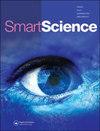纳米级零价镍:与不同表面活性剂和溶剂相互作用的合成和光谱研究
IF 1.4
Q2 MULTIDISCIPLINARY SCIENCES
引用次数: 0
摘要
摘要采用改性多元醇还原法,在不同的表面活性剂和溶剂中合成了高选择性镍纳米催化剂。用紫外-可见光谱法对这些纳米粒子进行了表征。用X射线衍射仪(XRD)技术研究了阴离子十二烷基硫酸钠(SDS)、阳离子N-正丁基-N,N,N-三甲基溴化铵(CTAB)和中性表面活性剂聚乙烯吡咯烷酮(PVP)的作用。通过场发射扫描电子显微镜、高分辨率透射电子显微镜和X射线光电子能谱技术分别证实了镍纳米颗粒(10nm以下)的形貌、粒径和氧化态。研究表明,以乙二醇为还原剂,PVP为封端剂的颗粒最小(2.4nm),无定形,均匀,分散性差。此外,在碱性水介质中,具有较小尺寸的颗粒被用作六氰基高铁酸盐(III)离子降解酸性橙10染料的催化剂。与镍前体盐相比,由于它们的小尺寸,颗粒尺寸显示出良好的催化活性。本文章由计算机程序翻译,如有差异,请以英文原文为准。
Nanoscale zero valent nickel: synthesis and spectral studies of interactions with different surfactants and solvents
ABSTRACT Highly selective nickel nanocatalysts were synthesized by modified polyol reduction methods with different surfactants and solvents. These nanoparticles were characterized by UV-Vis spectroscopy. The effect of anionic-sodium dodecyl sulfate(SDS), cationic-N-cetyl- N,N,N trimethyl ammonium bromide (CTAB) and neutral surfactant- polyvinyl pyrrolidone (PVP) was studied by X-ray diffractometer (XRD) technique. Morphology, particles size, and oxidation state of nickel nanoparticles (below 10 nm) were confirmed by Field Emission Scanning Electron Microscopy, High Resolution Transmission Electron Microscopy and X- ray Photoelectron Spectroscopic techniques, respectively. The study reveals that the particles using ethylene glycol as reductant and PVP as capping agent are smallest (2.4 nm), amorphous, homogeneous and less dispersed. Further, particles with smaller size are used as catalysts in the degradation of acid orange10 dye by hexacyanoferrate(III) ions in aqueous alkaline medium. The particles size show good catalytic activity as compared to nickel precursor salts due to their small size.
求助全文
通过发布文献求助,成功后即可免费获取论文全文。
去求助
来源期刊

Smart Science
Engineering-Engineering (all)
CiteScore
4.70
自引率
4.30%
发文量
21
期刊介绍:
Smart Science (ISSN 2308-0477) is an international, peer-reviewed journal that publishes significant original scientific researches, and reviews and analyses of current research and science policy. We welcome submissions of high quality papers from all fields of science and from any source. Articles of an interdisciplinary nature are particularly welcomed. Smart Science aims to be among the top multidisciplinary journals covering a broad spectrum of smart topics in the fields of materials science, chemistry, physics, engineering, medicine, and biology. Smart Science is currently focusing on the topics of Smart Manufacturing (CPS, IoT and AI) for Industry 4.0, Smart Energy and Smart Chemistry and Materials. Other specific research areas covered by the journal include, but are not limited to: 1. Smart Science in the Future 2. Smart Manufacturing: -Cyber-Physical System (CPS) -Internet of Things (IoT) and Internet of Brain (IoB) -Artificial Intelligence -Smart Computing -Smart Design/Machine -Smart Sensing -Smart Information and Networks 3. Smart Energy and Thermal/Fluidic Science 4. Smart Chemistry and Materials
 求助内容:
求助内容: 应助结果提醒方式:
应助结果提醒方式:


